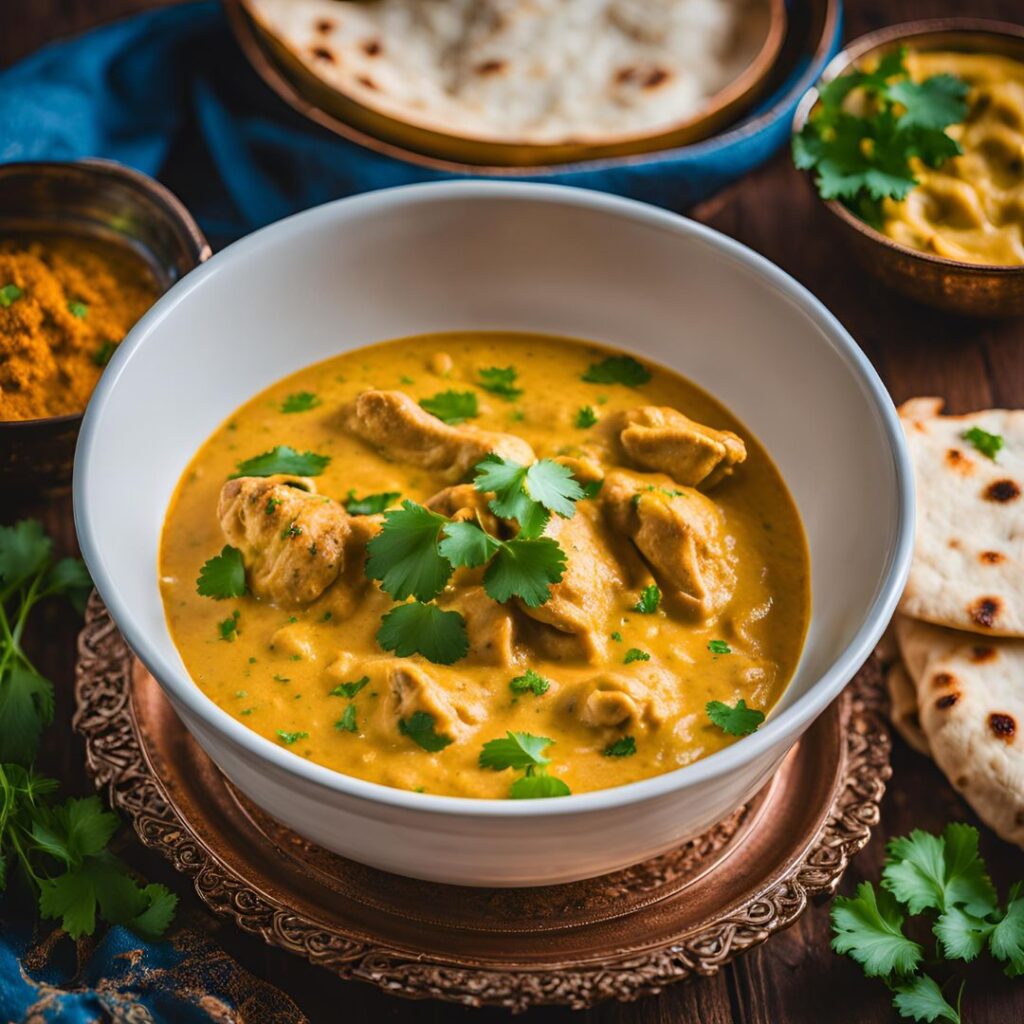

Chicken Korma Recipe: A Journey Into the Heart of Indian Cuisine. Indian cuisine is renowned for its rich, complex flavors and its ability to blend diverse ingredients in a harmonious symphony. Among the many dishes that have captivated the world with their aromatic and mouthwatering appeal, Chicken Korma stands out as one of the most beloved and enduring classics. A staple in South Asian kitchens and a favorite in Indian restaurants worldwide, Chicken Korma is a dish that embodies the essence of Mughlai cuisine—a legacy of royal courts, intricate spice blends, and culinary sophistication.
To truly appreciate Chicken Korma, it's essential to understand its origins. The word "korma" itself is derived from the Persian word "qorma," which means to braise or stew. Korma was introduced to the Indian subcontinent during the Mughal Empire (1526–1857), a period that saw the fusion of Central Asian, Persian, and Indian culinary traditions. The Mughals, known for their opulent lifestyles and love for lavish feasts, brought with them a refined approach to cooking that emphasized the use of yogurt, cream, nuts, and fragrant spices.
Initially, the dish was prepared with mutton, but over time, chicken became a popular alternative due to its tender texture and quicker cooking time. The slow-cooking process that defines a korma allows the meat to absorb the rich flavors of the spices and the creamy base, resulting in a dish that is both luxurious and comforting.
Chicken Korma, as we know it today, is a product of centuries of cultural exchange and adaptation. It is characterized by a delicate balance of spices that provides warmth without overwhelming the palate. Unlike some other Indian curries, which can be fiery and bold, Chicken Korma is celebrated for its subtlety and smooth, velvety texture.
What truly sets Chicken Korma apart from other Indian dishes is its unique combination of flavors and textures. The base of the curry is a luscious gravy made from a blend of aromatic spices, ground nuts (such as almonds or cashews), yogurt, and cream. This rich, creamy sauce is a perfect complement to the tender chicken, which absorbs all the complex flavors of the spices.
The distinctive sweetness of the korma comes from the use of nuts—often ground almonds, cashews, or a combination of both—along with the smooth texture of yogurt and cream, which add depth and richness to the dish. These ingredients also give Chicken Korma a slight sweetness that balances out the warmth of the spices, resulting in a multi-dimensional flavor profile.
The spices used in a traditional Chicken Korma are warm and fragrant. Common ingredients include cinnamon, cardamom, cloves, cumin, coriander, and nutmeg, all of which are tempered to create a mellow yet aromatic flavor. The gentle heat from these spices is tamed by the creaminess of the yogurt and cream, ensuring that the dish is rich without being overpowering.
Unlike some curries, which can have a pronounced tanginess or acidity, Chicken Korma is known for its luxurious smoothness, making it a crowd-pleaser for people who prefer a mild yet flavorful dish. It is often considered a comfort food for its richness and indulgence.
While the core principles of making Chicken Korma have remained relatively unchanged, this dish has been adapted in various regions of India and beyond to suit local tastes and preferences. For instance, in Northern India, the korma is usually made with a thicker, creamier sauce, while in Southern India, you might find variations that incorporate coconut milk for an extra layer of richness.
The beauty of Chicken Korma lies in its versatility. The dish can be made milder for those with a delicate palate or spicier for those who enjoy a bit of heat. The richness of the gravy can also be adjusted by varying the amount of cream, yogurt, and nuts used. While the classic version is typically made with chicken, the recipe can also be adapted to include other proteins such as lamb, beef, or even paneer for a vegetarian twist.
In recent years, health-conscious adaptations of Chicken Korma have become popular. Some cooks use lighter alternatives like low-fat yogurt or cashew paste instead of cream to reduce the calorie count while maintaining the dish’s signature texture. Others might experiment with sugar substitutes or omit certain ingredients to accommodate dietary restrictions, such as gluten-free or dairy-free diets.
Chicken Korma, like many other dishes in Indian cuisine, is more than just food; it holds cultural significance. In India, food is deeply intertwined with traditions, celebrations, and family gatherings. Korma, with its royal origins, often finds its way onto the table during special occasions—whether it be weddings, festivals, or important family celebrations. The dish is associated with hospitality and luxury, often served to guests as a symbol of respect and appreciation.
The popularity of Chicken Korma has extended well beyond India’s borders. As Indian food gained international fame, Chicken Korma became one of the most commonly ordered dishes in Indian restaurants worldwide. Its mild yet rich flavor profile makes it accessible to a wide range of people, from those new to Indian cuisine to seasoned food lovers looking for something comforting and indulgent.
In the West, Chicken Korma was often the first introduction to Indian food for many people. The dish's mild nature, combined with its creamy, nutty sauce, made it a favorite among diners who were initially hesitant about more pungent, spicy dishes. As the popularity of Indian food has grown globally, so too has the appreciation for the complexities of a dish like Chicken Korma.
Today, Chicken Korma enjoys a prominent place in modern Indian and fusion cuisine. While traditional recipes remain beloved by purists, chefs across the globe have begun to experiment with Korma in exciting ways. Some have given it a contemporary twist by adding unusual ingredients such as saffron, rose water, or dried fruits like raisins or apricots, which enhance the dish’s depth and appeal.
The global trend toward healthier eating has also seen Chicken Korma evolve. Many contemporary versions focus on cleaner, lighter ingredients while still preserving the dish’s rich, comforting essence. Low-fat dairy products, olive oil in place of ghee, and the use of more vegetables and lean meats are just some of the modifications that have emerged in the modern interpretation of this classic.
Moreover, the advent of meal prep culture and home-cooking enthusiasts has seen an increase in the popularity of instant pot and slow cooker versions of Chicken Korma. These innovations allow people to enjoy the complex flavors of this royal dish with minimal effort, bringing the essence of Mughlai cuisine into the modern kitchen.
In essence, Chicken Korma is more than just a dish; it is a cultural experience, a link between history and modernity, and a reminder of the richness of South Asian culinary traditions. Whether served at a grand feast or enjoyed as a simple weeknight meal, this dish offers a perfect blend of flavors and textures that has made it a staple in kitchens around the world. From its royal Mughal origins to its place in contemporary fusion cuisine, Chicken Korma continues to captivate the senses, proving that the classics never go out of style.
Yes! Chicken Korma actually tastes even better when made ahead of time because the flavors have more time to meld together. You can prepare the curry a day or two in advance and store it in an airtight container in the refrigerator. Simply reheat it gently on the stovetop, adding a little water or cream if needed to adjust the consistency.
Absolutely! Boneless, skinless chicken thighs are a great choice for Chicken Korma because they’re more flavorful and tender than chicken breasts. The richness of chicken thighs complements the creamy korma sauce very well. Simply adjust the cooking time slightly, as thighs may take a bit longer to cook than breasts.
Ghee adds a rich, nutty flavor to Chicken Korma, but if you don't have ghee, you can substitute it with vegetable oil or unsalted butter. For a healthier alternative, you can also use olive oil. Keep in mind that the flavor might be slightly different, but the dish will still be delicious.
Yes, you can make a dairy-free version of Chicken Korma! Instead of cream, you can use coconut milk for a creamy texture with a hint of sweetness. You can also use cashew cream (blend soaked cashews with water to make a smooth paste) as a substitute for both cream and yogurt. This will give the curry a rich, nutty flavor without any dairy.
Chicken Korma is generally considered a mild curry, especially compared to other Indian dishes like vindaloo or madras. The primary flavor profile of Chicken Korma is rich and creamy, with gentle warmth from spices like cardamom, cinnamon, and coriander. If you're concerned about the spice level, you can adjust the heat by reducing the amount of chili powder or omitting it altogether.
Yes! Chicken is the traditional meat for korma, but you can easily substitute it with lamb, beef, or goat meat. These proteins will need to cook longer than chicken, so adjust the cooking time accordingly. You can also make a vegetarian version by using vegetables like paneer (Indian cheese), cauliflower, potatoes, or carrots. Just follow the same recipe but cook the vegetables until they’re tender.
Yes, Chicken Korma freezes very well. Allow the dish to cool completely before transferring it to an airtight container or freezer-safe bag. You can freeze it for up to 2-3 months. When you're ready to eat, defrost the curry in the fridge overnight and then reheat it on the stovetop over low heat. You may need to add a little water or cream to bring it back to the desired consistency.
Chicken Korma pairs wonderfully with a variety of accompaniments. The rich and creamy sauce is perfect for soaking up with naan (Indian flatbread) or paratha. You can also serve it with basmati rice or jeera rice (cumin-flavored rice). For a complete meal, add a side of raita (yogurt with cucumber and spices) or a salad to balance the richness of the curry.
If your Chicken Korma sauce is too thin, there are a few ways to thicken it. You can:
Yes, you can adjust the sweetness of Chicken Korma to your liking. The sweetness in Korma comes primarily from the ground nuts and cream. If you prefer a sweeter Korma, you can add a teaspoon of sugar or honey. On the other hand, if you prefer less sweetness, reduce the amount of cream or yogurt, and skip any additional sweeteners. Just remember to taste as you go to find the perfect balance.
Enjoy the yum :)